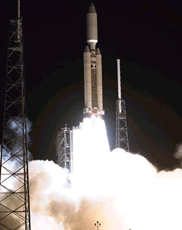Www.nasa.gov games
 Escape Velocity: Fun and Games
Escape Velocity: Fun and Games
Image to left: A Delta IV rocket launches at night. Credit: NASA
If Sally breaks through the chain of arms, she's also demonstrated several key aspects to the space concept of escape velocity. Escape velocity (or a rousing game of Red Rover) requires an object to propel itself with enough speed and thrust to break through a barrier. Sally's reward is the cheers of her teammates. A spacecraft's reward is a journey into space or orbit.
Escape velocity is the speed at which an object must travel to break free of a planet or moon's gravitational force and enter orbit. A spacecraft leaving the surface of Earth, for example, needs to be going about 11 kilometers (7 miles) per second, or over 40, 000 kilometers per hour (25, 000 miles per hour), to enter orbit.
An Endless Cycle
Image to right: A Saturn V rocket is prepared for launch. Credit: NASA
That cycle of speed, fuel and weight was a primary reason the Saturn V rocket that took the first astronauts to the Moon was so large. It required such enormous quantities of fuel to break free of the Earth's gravitational pull that a vehicle of this size was the only workable solution. The Space Shuttle in use now is much smaller, but it doesn't have nearly as far to travel or nearly as much gravitational force to overcome. Future space propulsion projects, such as magnetic levitation, could reduce size requirements because speed and propulsion will be created in a manner that doesn't require large fuel tanks.
Image to right: This illustration shows possible orbital paths. Credit: NASAYou might also like










